8369 Austro-Hungarian Empire mounted medal grouping WW1 ribbon bar dog tag
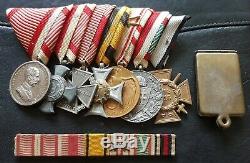
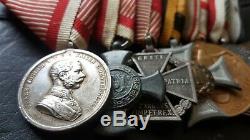
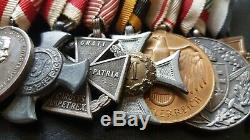
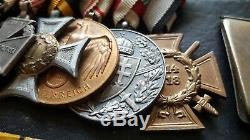
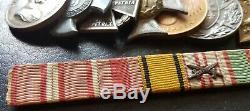
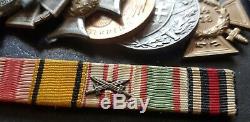
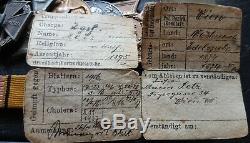
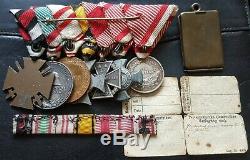
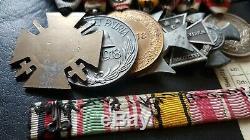
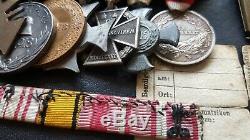
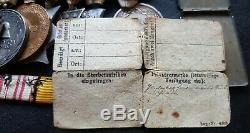

Original WW1 Austro-Hungarian Empire medal grouping. Parade mounted medal group (intact pin device, good ribbons, very nice group). Austro-Hungarian Empire / Silver Bravery Medal Franz Joseph I. Austro-Hungarian Empire / Iron Cross of Merit. Austro-Hungarian Empire / Karl Troop Cross.
Austro-Hungarian Empire / Military Service Cross for 6 Years' Service. Austrian War Commemorative Medal With Swords. Hungarian War Commemorative Medal for Combatants. German Honour Cross With Swords. Matching ribbon bar for the awards above.
Dog tag in genuine brass / copper holder. Since 1809 this was known as the Bravery Medal or Tapferkeitsmedaille. On the 19th August 1848 Kaiser Ferdinand divided the Silver Bravery Medal into two classes - a First and a Second Class. The 2nd Class Medal being a smaller version with a diameter of 31mm. On the 14th February 1915 Kaiser Franz Joseph introduced the Bronze Medal which was the same size as the 2nd Class Silver.
Unlike the three senior awards, the Bronze Medal could be awarded to NCOs and Private Soldiers of allied armies. The Bravery Medals displayed the reigning Kaiser's head on the obverse.
In the case of Franz Joseph, he was depicted in a Marshals' uniform and the following inscription was placed around the outer edge of the medal: FRANZ JOSEPH I. OESTERREICH (Franz Joseph I, by the grace of God Emperor of Austria).
The obverse showed six crossed regimental colours surrounded by a laurel wreath and the motto: "Der Tapferkeit". The diameter of the Gold and large Silver Medal was 40mm.The ribbon of the Bravery Medal was the same white and red ribbon as the Military Merit Cross. An Imperial Decree of the 29th November 1915 introduced bars for repeat awards and these took the form of an 8mm wide smooth rustless iron bar. The recipient of a Bravery Medal was entitled to a lifelong pension and as ordered by the "Zirkularverordnung" of 18th September 1914 the sums were as follows with effect from the1st October 1914: Golden Bravery Medal - 30 Crowns per month, Silver Bravery Medal 1st Class - 15 Crowns per month, Silver Bravery Medal 2nd Class - 7.50 Crowns per month. With effect from the 4th April 1917 as published in the Normal-Verordnungsblatt Nr.
18 new versions of the Medal were introduced bearing the new Kaiser's portrait and the inscription: CAROLVS D. The reverse was altered to bear the Motto "FORTITVDINI".
A further change was the newly introduced eligibility for Commissioned Officers to be awarded the Golden and Silver Bravery Medals with effect from the 15th of September 1917 although the Officers' Awards did not attract the monthly pension. The Officers' version was distinguished by the addition to the triangular ribbon of a gold or silver "K". Although the awards to NCOs and Men were delegated to Army Commanders in the field those of the Golden and Silver Medals for Officers remained an Imperial prerogative. The cross was instituted on 1 April 1916 in two grades Iron with and without Crown as a need had been perceived for a grade below the existing Gold and Silver to reward the many people of lower ranks performing exceptional acts and services, especially in the support and auxiliary services.Karl Troop Cross (Karl Truppenkreuz) was instituted on 13 December 1916 by Emperor Karl I of Austria-Hungary. The cross was awarded until the end of the First World War to soldiers of the Austro-Hungarian Army , regardless of rank, who had been with a combatant unit for at least twelve weeks and who had actually served at the front. The medal is of zinc and consists of a cross pattée resting on a laurel wreath. The reverse shows the Austrian and Hungarian Imperial crowns above the letter "C" (for Carolus) with the inscription "VITEM ET SANGVINEM", (With life and blood) and the date MDCCCCXVI, (1916).
The cross was worn on the left chest from a red ribbon with alternate red-white side strips towards each edge. A total of 651,000 were awarded. Military Long Service Cross for non-commissioned officers and other ranks, III class for 6 years service Militärdienstzeichen für Unteroffiziere und Mannschaften, 3. The Decoration was instituted on 12 March 1890 to reward long and faithful service in the Austro-Hungarian armed forces and was issued in different versions for officers, for non-commissioned officers and for other ranks and for completion of various periods of service. This example is of the fourth and last version for other ranks on completion of 6 years loyal service, awarded from 1913 until the dissolution of the Austro-Hungarian Empire at the end of World War I in November 1918.
Austrian War Commemorative Medal (Kriegserinnerungsmedaille) Awarded to all who served in the First World War. This medal was instituted on 21 december 1932 and on 10 November 1933 gilt crossed swords were decreed. These were to be attached to the medal's ribbon for those who served under fire at the front, wounded and POW who had behaved with honour.
The obverse depicts an eagle with wings opened downwards, standing on an upright shield with the Austrian weapon. Along the lower rim are the words "FÜR ÖSTERREICH" (For Austria).
Hungarian Commemorative Medal of the World War - Awarded "with helmet and swords" to soldiers and other combattants or "without helmet and swords" to all other war participants or to the nearest relative of a soldier. This medal was instituted on 26 May 1929 by the Regent, Admiral Horthy. The obverse shows the weapon shield of Hungary surmounted by a crown and, if so awarded, with swords underneath the shield. In case of the award "without helmet and swords", the ribbon is white with green-red-white side stripes. German Cross of Honor, a. Hindenburgkreuz, Frontkämpferehrenkreuz (Ehrenkreuz des Weltkrieges 1914/1918) - Ehrenkreuz des Weltkrieges 1914/1918 was instituted on July 13, 1934 by the President Generalfeldmarshall Paul von Hindenburg aiming to commemorate all those who fought and fell during the Great War and therefore was nicknamed Hindenburg Cross. Cross of Honor was awarded to frontline veterans and non-combatants German citizens and Germans who lost their citizenship due to the Versailles Peace Treaty as well as to relatives of the fallen soldiers their widows and parents. Thus it aim was to reinforce pride not only in veterans but also military personnel of German Armed forces. Cross of Honor was instituted in three classes: 1.Cross of Honor for frontline soldiers (Ehrenkreuz für Frontkämpfer). It was awarded only for the military personnel of the Imperial Army and Navy who had engaged the enemy in frontline combat.
Cross of Honor for war participants, i. It was awarded to military auxiliary personnel such as administrators and medics, as well as to civilians state officials, etc. Cross of Honor for next-of-kin (Ehrenkreuz für Hinterbliebene).It was issued to widows and parents of those who were killed or died during WWI or were missing in action. Award was issued after an application accompanied by a prove of wartime service or loss of a relative was approved by the authorities, the Reichsminister of interior being in charge of the distribution of crosses. Cross of Honor was handed personally to the active military personnel and sent by post to veterans and civilians. Ehrenkreuz des Weltkrieges was created by Eugene Godet who received commission from the Reich Chancellery and its design was based on that of the Prussian Kriegsdenkmünze für die Feldzüge 1870/1871 Kriegsdenkmünze für die Feldzüge 1870/1871 reverse.
It had a form of an equilateral 37x37 mm Teutonic cross with a 1 mm raised edge line and a recessed field. Two dates referring to the Great War were placed over each other in the central medallion 1914 and 1918. The upper arm of the cross had a 1,5-2 mm ribbon ring through which a ribbon loop ran. Three classes of the Honor Cross differed by the following details. Cross of Honor for frontline soldiers made of bronze or bronzed iron had a wreath of laurels on the center, tied at the base by a ribbon tie with the ends extending to the lower arm of the cross.
The wreath was composed of five bunches of three leaves on each side, with a pair of laurel berries at each joint. A pair of 41 mm crossed swords were placed through the arms of the cross. Tricolor 25-30 mm ribbon featured central red stripe and black and white stripes on both sides accompanied by thin black stripes closer to both edges. Sometimes a crossed swords gilt device was worn on the ribbon. Cross of Honor for war participants made of bronze or bronzed iron was of a nearly similar design but had a wreath of oak leaves and lacked swords.Its ribbon was similar to that of the Cross of Honor for frontline soldiers. Cross of Honor for next-of-kin was similar to the Cross of Honor for war participants but was finished in black and its ribbon colors were inverted, i.
Central red stripe and white and black stripes on both sides accompanied by thin white stripes closer to both edges. Its worth mentioning here that though award documents for the Cross of Honor for next-of-kin were of two different types (Ehrenkreuz für Witwen and Ehrenkreuz für Eltern) the award itself was only of one type as described above. The rarest type of the Cross of Honor for next-of-kin was made of iron and had a horizontal pin and catch on its reverse instead of ribbon ring that was missing.All three classes of the award had a flat reverse with makers mark. Ehrenkreuz des Weltkrieges was made of bronze or iron. The Cross of Honor was worn mounted as part of a group or on the ribbon bar.
The award ranked above service and occupation medals but below combat related awards. Number of awards: Ehrenkreuz für Frontkämpfer 6,202,883 pieces, Ehrenkreuz für Kriegsteilnehmer 1,120,449 pieces, Ehrenkreuz für Hinterbliebene 345,112 pieces issued to widows with Ehrenkreuz für Witwen award document and Ehrenkreuz für Hinterbliebene 372,950 pieces issued to parents who lost their sons with Ehrenkreuz für Eltern award document.
The item "8369 Austro-Hungarian Empire mounted medal grouping WW1 ribbon bar dog tag" is in sale since Friday, May 24, 2019. This item is in the category "Collectables\Militaria\World War I (1914-1918)\Medals/ Ribbons".anderson" and is located in Abbots Langley.
This item can be shipped worldwide.
- Country/ Organization: Germany
- Type: Medals & Ribbons
- Conflict: World War I (1914-1918)
- Era: 1914-1945

